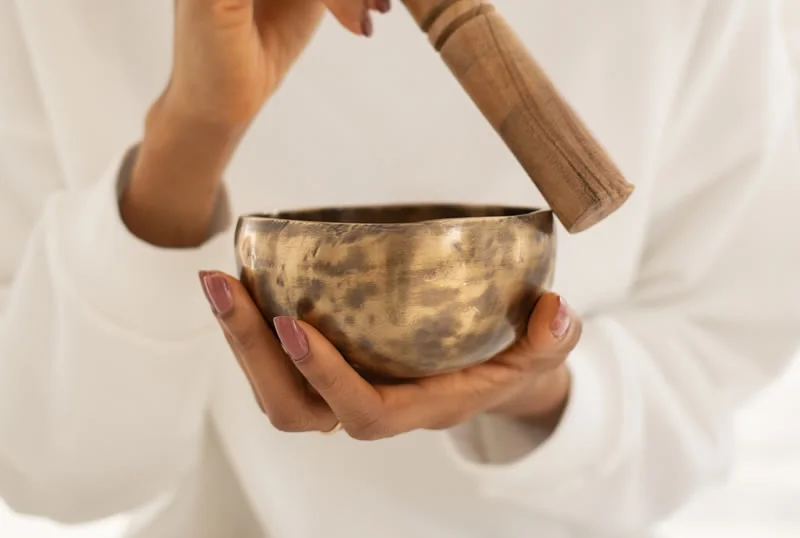Tibetan Sound bowls have been used in many religious and spiritual practices, from Buddhism to Christianity, for centuries.
But, what is the connection between them and different cultures? Are singing bowls religious?
This article will discuss the history of singing bowls and how they have been used in religious practices. We will also look at the spiritual aspects of singing bowls and how they are used for meditation and relaxation.

Key Takeaways
- Singing bowls have been used for centuries in various traditions and societies.
- They have cultural, spiritual, and therapeutic significance.
- They are believed to have healing properties for the mind and body.
- Sound bowls can enhance mindfulness practices and promote relaxation.
Content
Singing Bowls and Religion History
Singing bowls have a rich history that dates back over 2500 years. These metallic instruments are believed to have originated from the Himalayan region, particularly in present-day Nepal, Tibet, and India.
Despite being named singing bowls, they are also referred to as Himalayan bowls, Tibetan bowls, or sound bowls.
The exact use of them in ancient times is not entirely clear, but it is believed that they were initially used for spiritual rituals and meditation.
Some accounts suggest that they were initially made to be used as food bowls, but their unique sound quality led to their use for spiritual purposes.
Tibetan bowls were also used in traditional medicine practices to treat physical and psychological ailments.
Throughout history, they have undergone several modifications in terms of their shape, size, and material.
Early examples were carved from a metal alloy known as panchaloga, which consists of five different metals, including copper, zinc, and iron.
Later versions were made using brass, which is a more affordable and malleable metal that can reproduce the same sound quality as panchaloga bowls.
As singing bowls gained popularity across the world, they started to take on different forms and designs, becoming more ornate and artistic in appearance.
However, the underlying concept and usage of singing bowls remained largely the same.
Cultural Aspects of Singing Bowls
Singing bowls have deep roots in various cultures, where they are used for spiritual and healing purposes. The bowls are believed to have originated from Tibet and Nepal and quickly spread to other parts of Asia, such as Japan, China, and India.
In Tibetan culture, they’re central to religious practices and used for manifestation, meditation, chanting, and rituals.
The bowls are often made of a mixture of metals, each believed to have its unique healing properties. These properties are believed to be enhanced through the chanting and meditation that accompany the use of the bowls.

In Japan, bowls are used in Zen Buddhism. They are struck or played while meditating to help focus the mind and promote relaxation.
Similarly, in Chinese Taoist practices, these bowls are used to balance the body’s energy and promote inner peace.
In India, singing bowls are part of the Ayurvedic healing tradition. The bowls are used to balance chakras, the energy centers in the body, by producing a specific sound frequency that resonates with each chakra. Balancing the chakras is believed to promote physical and emotional healing.
Across cultures, singing sound bowls are often considered sacred objects. They are handled with reverence and are believed to hold spiritual energy.
Many cultures believe that these instruments have the power to connect the physical and spiritual worlds.
The Role of Singing Bowls in Shamanic Traditions
In addition to their use in religious and spiritual practices, singing bowls have also played a role in shamanic traditions.
In shamanic healing ceremonies, the bowls are used to help participants enter a trance-like state, where they can experience spiritual visions or receive guidance from the spirit world.
Singing bowls are believed to create a bridge between the physical and spiritual realms, allowing shamanic practitioners to access the spiritual energies needed for healing.
The bowls are often played in conjunction with other instruments, such as drums and rattles, to create a harmonious and powerful sound that promotes healing and transformation.
Overall, they are a significant part of various cultures and spiritual traditions. They have been used for centuries to promote healing, balance energy, and connect with the spiritual world.
Spiritual Significance of Singing Bowls
If you’ve ever attended a meditation class or visited a spa, you’ve likely encountered one of these bowls. These ancient instruments have been used for centuries in spiritual practices and are believed to have powerful healing properties.
The religious and spiritual value varies depending on the culture and tradition. In certain Buddhist practices, singing bowls are used in meditation to help practitioners achieve a deep state of relaxation and spiritual awakening.
Similarly, in Hinduism, they’re used during prayer and are believed to enhance the effectiveness of the mantra being recited.
The Chakra System
One common belief among spiritual practitioners is that singing bowls can help balance the body’s chakra system. Chakras refer to energy centers in the body, and each is said to correspond to a specific aspect of physical, emotional, and spiritual health.
By using singing bowls to produce specific frequencies, it’s believed that practitioners can align and balance the chakras, promoting overall well-being.
Sound Treatment
In addition to their spiritual significance, singing bowls are also used in sound therapy. This form of therapy involves producing specific frequencies and vibrations to promote relaxation and healing.
During a sound therapy session, a practitioner may use a variety of instruments, including singing bowls, to create a soothing and peaceful environment.
Proponents of sound therapy believe that it can help reduce stress, ease pain, and promote feelings of well-being. While the scientific evidence for the effectiveness of sound therapy is limited, many people find it to be a helpful complement to traditional medical treatments.
Uses of Singing Bowls
While singing bowls have long been associated with spiritual traditions, they are increasingly being used in therapeutic and wellness settings.
Here are some of the most common uses:
Meditation
Singing bowls are often used during meditation practice to help focus and quiet the mind. The sound vibrations produced by the bowls can induce a deep state of relaxation and enhance the meditative experience.
Mindfulness
Similar to meditation, they can also be used to cultivate mindfulness. By focusing on the sound and vibration of the bowl, practitioners can become more present and aware of their surroundings.
Sound Therapy
Many practitioners of alternative and holistic medicine use singing bowls as part of sound therapy sessions.
The vibrations from the bowls can have a calming effect on the nervous system and may help alleviate symptoms of anxiety and stress.
Chakra Balancing
In some spiritual traditions, singing bowls are believed to be able to balance the body’s energy centers or chakras. By placing the bowl on specific points on the body and producing specific tones, practitioners aim to restore balance and harmony to the mind and body.
Overall, singing bowls have evolved from purely religious artifacts into versatile tools for promoting relaxation and well-being.
Whether you use them for meditation, mindfulness, or sound therapy, their unique sound and vibration can help you achieve a more peaceful state of mind.
Healing Properties of Singing Bowls
For centuries, singing bowls have been used for their potential healing properties. Proponents claim that the sound vibrations produced by the bowls can promote relaxation and stimulate the body’s natural healing processes.
One popular theory is that the sound waves from the bowls can help to balance the chakras, which are believed to be energy centers in the body.
Each chakra is associated with a specific color and sound frequency, and the sound bowls are thought to emit these frequencies, helping to restore balance and harmony.
| Chakra | Color | Frequency |
|---|---|---|
| Root | Red | 194.18 Hz |
| Sacral | Orange | 210.42 Hz |
| Solar Plexus | Yellow | 126.22 Hz |
| Heart | Green | 136.10 Hz |
| Throat | Blue | 141.27 Hz |
| Third Eye | Indigo | 221.23 Hz |
| Crown | Purple | 172.06 Hz |
Studies have also suggested that the sound vibrations from singing bowls can help reduce stress and anxiety levels, lower blood pressure, and improve circulation.
Some people also claim that they have experienced relief from chronic pain and headaches after using singing bowls.
“The sound vibrations of these bowls is a form of energy medicine that can help to balance and align the body’s energy systems, promoting overall health and wellbeing.” – Dr. Mitchell Gaynor
It is important to note that while they may have potential health benefits, they should not be used as a replacement for medical treatment or advice from a healthcare professional.
It is always best to consult with a doctor before using one as part of any treatment plan.
Mindfulness and Singing Bowls
These beautiful instruments are often used in meditation and can be a helpful tool in enhancing your practice. Here are some ways that singing bowls can promote mindfulness and relaxation:
| Benefits of Singing Bowls in Mindfulness Practices | Description |
|---|---|
| Focus and Concentration | They can help you focus on your meditation practice, as the sound and vibrations can help calm and center your mind. |
| Reducing Stress and Anxiety | The soothing sounds of singing bowls can help reduce stress and anxiety in the body, allowing you to feel more relaxed and centered. |
| Sensory Experience | The sound and physical sensation of bowls can be a helpful tool in bringing your attention to the present moment and engaging your senses. |
When incorporating singing bowls into your mindfulness practice, it’s important to choose a bowl that resonates with you and produces a sound that you find calming and soothing.
You can experiment with different sizes and materials to find the bowl that works best for you.
Try incorporating singing bowls into your meditation practice. You can begin by striking the bowl gently and holding the tone for as long as it feels comfortable.
Focus on the sound and vibrations, breathing deeply and allowing your mind to relax and center.
Conclusion
So, are singing bowls religious? While they may have religious origins, their uses have expanded beyond religion to include meditation, mindfulness, and sound therapy.
The rich history shows how they have evolved over time and spread across different parts of the world.
From their origins in the Himalayas to their use in Buddhist and Hindu practices, singing bowls have a deep cultural significance.
The mindfulness-enhancing properties of singing bowls make them particularly useful for those seeking to deepen their meditation practice and promote relaxation.
Overall, while singing bowls may have religious origins, they have become well-known as therapeutic tools that promote relaxation and wellness.
